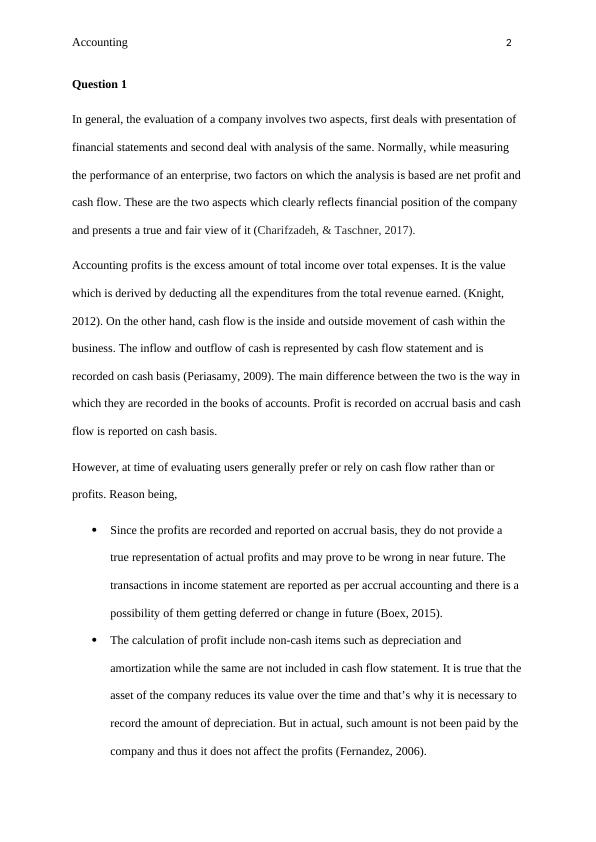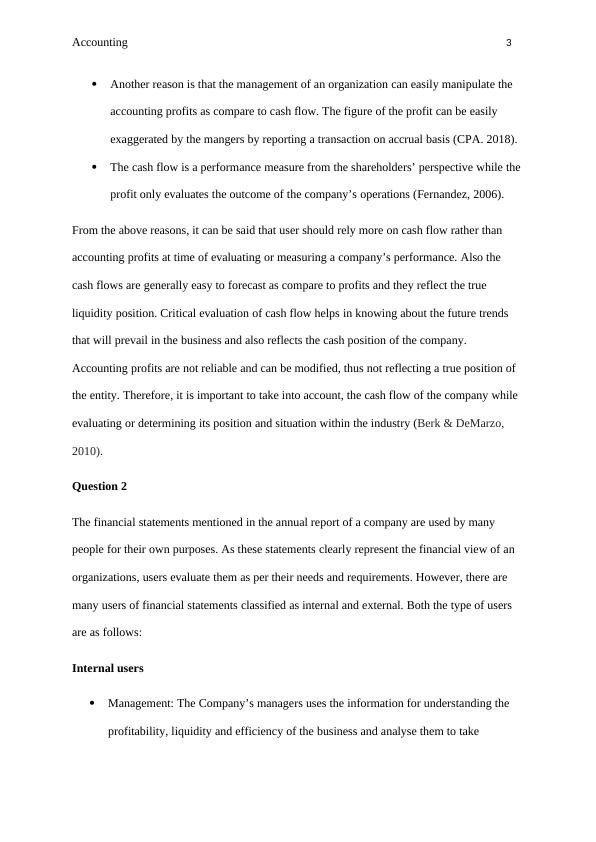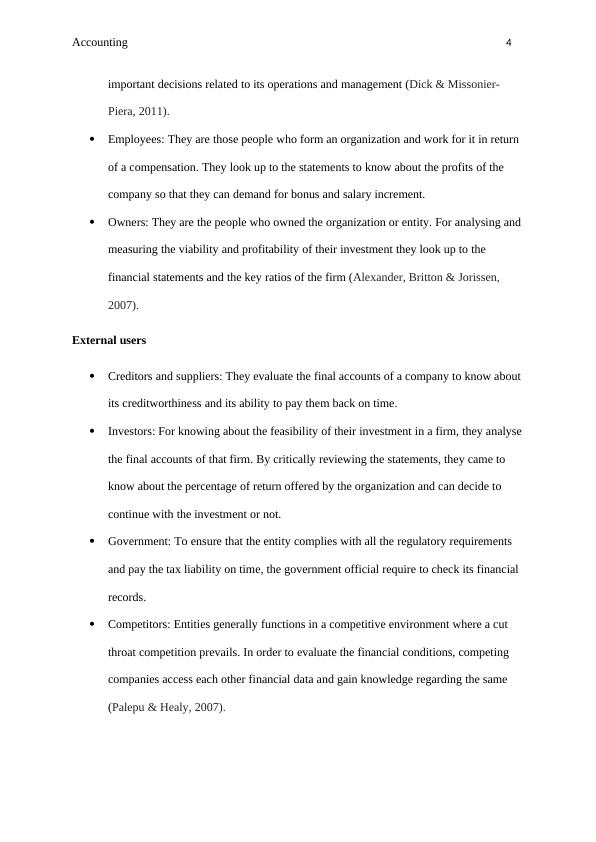Accounting for Decision Making Question 1
Added on 2021-06-17
14 Pages3224 Words148 Views
RUNNING HEAD: ACCOUNTINGAccounting for decision making

Accounting 2Question 1In general, the evaluation of a company involves two aspects, first deals with presentation of financial statements and second deal with analysis of the same. Normally, while measuring the performance of an enterprise, two factors on which the analysis is based are net profit andcash flow. These are the two aspects which clearly reflects financial position of the company and presents a true and fair view of it (Charifzadeh, & Taschner, 2017).Accounting profits is the excess amount of total income over total expenses. It is the value which is derived by deducting all the expenditures from the total revenue earned. (Knight, 2012).On the other hand, cash flow is the inside and outside movement of cash within the business. The inflow and outflow of cash is represented by cash flow statement and is recorded on cash basis (Periasamy, 2009).The main difference between the two is the way in which they are recorded in the books of accounts. Profit is recorded on accrual basis and cashflow is reported on cash basis. However, at time of evaluating users generally prefer or rely on cash flow rather than or profits. Reason being,Since the profits are recorded and reported on accrual basis, they do not provide a true representation of actual profits and may prove to be wrong in near future. The transactions in income statement are reported as per accrual accounting and there is a possibility of them getting deferred or change in future (Boex, 2015).The calculation of profit include non-cash items such as depreciation and amortization while the same are not included in cash flow statement. It is true that theasset of the company reduces its value over the time and that’s why it is necessary to record the amount of depreciation. But in actual, such amount is not been paid by the company and thus it does not affect the profits (Fernandez, 2006).

Accounting 3Another reason is that the management of an organization can easily manipulate the accounting profits as compare to cash flow. The figure of the profit can be easily exaggerated by the mangers by reporting a transaction on accrual basis (CPA. 2018).The cash flow is a performance measure from the shareholders’ perspective while theprofit only evaluates the outcome of the company’s operations (Fernandez, 2006).From the above reasons, it can be said that user should rely more on cash flow rather than accounting profits at time of evaluating or measuring a company’s performance. Also the cash flows are generally easy to forecast as compare to profits and they reflect the true liquidity position. Critical evaluation of cash flow helps in knowing about the future trends that will prevail in the business and also reflects the cash position of the company. Accounting profits are not reliable and can be modified, thus not reflecting a true position of the entity. Therefore, it is important to take into account, the cash flow of the company while evaluating or determining its position and situation within the industry (Berk & DeMarzo, 2010).Question 2The financial statements mentioned in the annual report of a company are used by many people for their own purposes. As these statements clearly represent the financial view of an organizations, users evaluate them as per their needs and requirements. However, there are many users of financial statements classified as internal and external. Both the type of users are as follows:Internal users Management: The Company’s managers uses the information for understanding the profitability, liquidity and efficiency of the business and analyse them to take

Accounting 4important decisions related to its operations and management (Dick & Missonier-Piera, 2011).Employees: They are those people who form an organization and work for it in return of a compensation. They look up to the statements to know about the profits of the company so that they can demand for bonus and salary increment. Owners: They are the people who owned the organization or entity. For analysing andmeasuring the viability and profitability of their investment they look up to the financial statements and the key ratios of the firm (Alexander, Britton & Jorissen, 2007).External usersCreditors and suppliers: They evaluate the final accounts of a company to know aboutits creditworthiness and its ability to pay them back on time. Investors: For knowing about the feasibility of their investment in a firm, they analysethe final accounts of that firm. By critically reviewing the statements, they came to know about the percentage of return offered by the organization and can decide to continue with the investment or not.Government: To ensure that the entity complies with all the regulatory requirements and pay the tax liability on time, the government official require to check its financial records. Competitors: Entities generally functions in a competitive environment where a cut throat competition prevails. In order to evaluate the financial conditions, competing companies access each other financial data and gain knowledge regarding the same (Palepu & Healy, 2007).

End of preview
Want to access all the pages? Upload your documents or become a member.
Related Documents
Study on Government and Non Profit Accountinglg...
|6
|939
|53
Cash and Accrual Basis of Accounting.lg...
|9
|1874
|23
Difference between Income Statement and Cash Flow Statementlg...
|3
|934
|477
Difference between Cash Flow and Net Profitlg...
|3
|753
|58
Five Accounting Concepts and Qualitative Characteristics of Financial Reportlg...
|7
|1418
|164
Accounting for Business: Concepts and Qualitative Characteristics of Financial Reportslg...
|7
|1478
|99
